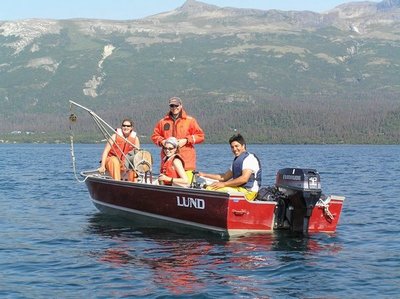July 10, 2008
Understanding salmon as ecosystems in action
The collapse of the Sacramento River chinook salmon run may be another lesson on the importance of coming to grips with the biocomplexity behind successful salmon runs.
The fish may have lost too much genetic diversity or habitat to be able to weather the environmental challenges encountered at sea, according to Ray Hilborn, UW professor of aquatic and fishery sciences. The depleted runs this year were so mysterious that a New York Times story was headlined, “Chinook salmon vanish without a trace.” The declines were so severe fishing was halted for all salmon off Oregon and California.
Biocomplexity is the study of the interrelationships among living things — from their genes to the ecosystems where they live to their interactions with their environment. It’s not enough to just chronicle what is in ecosystems. There also needs to be a way to understand wide-ranging behavioral, biological, chemical and physical interactions in order to consider how species and environments may respond to such things as climate change or human activities.
Hilborn and UW faculty members Thomas P. Quinn and Daniel Schindler are leaders of a project to sort out the multitude of factors that give salmon runs resiliency. The project also will provide fisheries managers with computer programs and skills they need to account for such factors in their plans. That work, funded the last three years with $2.7 million from the Gordon and Betty Moore Foundation, has just received an additional $3.6 million from the foundation for three more years.
“We have argued that if you lose the biocomplexity, then there may not be the genetic and habitat resources to respond to environmental change,” Hilborn says.
Understanding the role of salmon biodiversity could help managers around the world. The foundation money, for example, will help extend training management techniques to fishery planners in Russia, a country key to global salmon sustainability because its runs are so abundant. Such analysis might help explain what happened to the Sacramento River salmon or, even better, might have alerted managers and fishers to a looming problem.
The work builds on data collected as part of the UW’s Alaska Salmon Program, the world’s longest-running effort to monitor salmon and their ecosystems. UW aquatic and fishery researchers have collected information since 1946, more than a decade before Alaska became a state. At that time, salmon biology and management was poorly understood and UW scientists developed many basic techniques for counting salmon and understanding their life cycles.
The work was initially launched to help fishers and managers understand the size of salmon runs, particularly sockeye, but early UW program leaders also collected basic information about such things as the weather, lake levels, insects, zooplankton and other fish species. Such information makes the UW dataset the most comprehensive of any program monitoring healthy salmon runs anywhere, Hilborn says.
The additional money funds the UW’s Alaska program for the next three years and expands what scientists have been doing — for instance, allowing them to sample more streams, more often. They’ll also have the chance to monitor not only sockeye but other salmon species. Although far less abundant than sockeye, the other salmon species have been increasing in number and scientists would like to know why.
At the same time, efforts have been under way to get all the program’s data into a modern computer database system, work that sometimes requires going back to the raw field notebooks from decades past.
Growing amounts of data mean fishery managers need to learn new ways to balance complex sets of variables when considering how a fishery might respond to different management plans, Hilborn says. The award will allow researchers to continue developing five basic models and to generate a handbook on using them.
The award comes just months after the UW’s School of Aquatic and Fishery Sciences launched a $4.1 million effort to gather genetic information for tens of thousands of Pacific Rim salmon populations and create open-access databases for managers, treaty-makers and scientists.



